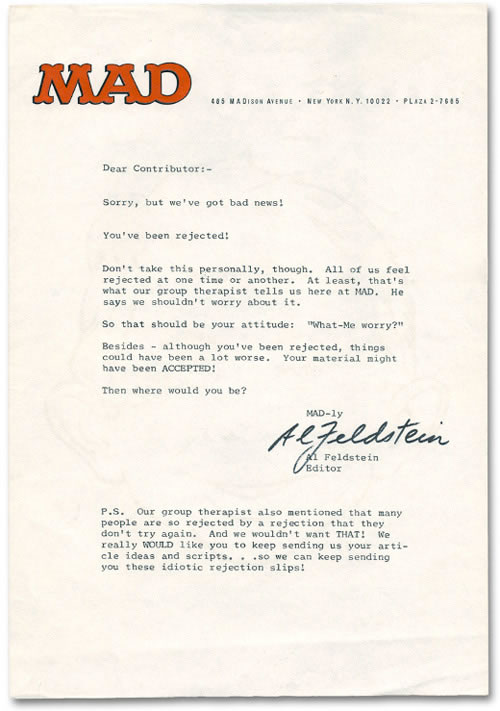Archive for July, 2010
Public Libraries Are Beating Netflix, Redbox and Blockbuster in DVD Rentals [DVD]
All my friends are dead
An animated gif made with the first 10 pages of Avery Monsen and Jory John’s book, All My Friends Are Dead…
[via the daily what]

Mad Magazine Rejection Letter
Leave it to Mad Magazine to craft a rejection letter that doesn’t leave you feel too rejected:
There’s nothing like a helping of light-hearted humour to ease the pain of rejection, as evidenced by this form letter from the offices of Mad magazine, one of the most influential humour publications ever released. The letter was sent to all unsuccessful submitters of material during the much-lauded reign of Al Feldstein.
From the always awesome Letters of Note – via Nerdcore
Ghosts now officially exist, thanks to Sergey Larenkov’s computational rephotography

Photographer Sergey Larenkov uses computational rephotography (as shown above and explained here by Wired) to overlay extant WWII-era photographs on their corresponding modern settings. The results are both spooky and stunning:

The shots really do have to be seen large, so check out Larenkov's LJ page for the rest of 'em.
via gizmodo
Scientists Measure Shortest Interval of Time Ever
 German scientists hit electrons with light and then measured how they soon they moved. The delay between the bombardment and the movement of those electrons is the shortest interval of time ever measured, which is 20 attoseconds. An attosecond is one quintillionth of a second.
German scientists hit electrons with light and then measured how they soon they moved. The delay between the bombardment and the movement of those electrons is the shortest interval of time ever measured, which is 20 attoseconds. An attosecond is one quintillionth of a second.
When light is absorbed by atoms, the electrons become excited. If the light particles, so-called photons, carry sufficient energy, the electrons can be ejected from the atom. This effect is known as photoemission and was explained by Einstein more than hundred years ago. Until now, it has been assumed that the electron start moving out of the atom immediately after the impact of the photon. This point in time can be detected and has so far been considered as coincident with the arrival time of the light pulse, i.e. with “time zero†in the interaction of light with matter.
The scientists tested the assumption, and this is what happened:
Their measurements revealed that electrons from different atomic orbitals, although excited simultaneously, leave the atom with a small but measurable time delay of about twenty attoseconds.
In the comments, provide practical illustrations of the shortest intervals of time.
Link via Popular Science | Photo: Thorsten Naeser / Max-Planck-Institute of Quantum Optics
Did the Sultan of Brunei Buy 10 Aston Martin One-77s for His Billion-Dollar Car Collection?

Back in February we reported on the mysterious filthy rich individual who purchased 10 Aston Martin One-77 supercars, limited to just 77 examples, for $1.7 million apiece or $23 million in total including fees. Now educated insiders are speculating that the Sultan of Brunei bought the cars to add to his multi-billion-dollar, 7,000-strong car collection, the world's most expensive auto hoard. According to Guinness World Records the Sultan's collection includes over 600 Rolls-Royces, more than 450 Ferraris, 570 Mercedes-Benzes, 380 Bentleys, 170 Porsches, dozens of Koenigseggs, and 20 Lamborghinis to name a few. He owns several rare custom, one-off and concept cars, some worth tens of millions apiece, including a Ferrari Mythos, a Jaguar XJ220 by Pininfarina, a Bentley Java, a Bentley Dominator SUV, bespoke Rolls-Royce and Ferrari station wagons, a Porsche Carma and a Koenigsegg Agera. Known for buying multiple models of supercars in order to have one in every color, he owns several McLaren F1s, six Ferrari FXXs, four Ferrari F40s and three Ferrari F50s. The Sultan, who's worth an estimated $20 billion, stores the collection in five heavily-guarded airplane hangars and employs a team of mechanics and specialists to keep the cars in perfect working condition.
Filed under: Luxury Cars & Autos, Wealth
Did the Sultan of Brunei Buy 10 Aston Martin One-77s for His Billion-Dollar Car Collection? originally appeared on Luxist on Thu, 29 Jul 2010 18:02:00 EST. Please see our terms for use of feeds.
Read | Permalink | Email this | Comments







The Amish Population Boom
 Thanks to high birth rates and few people exiting the sect, the Amish population in the United States is surging:
Thanks to high birth rates and few people exiting the sect, the Amish population in the United States is surging:
The Amish population — a religious group that limits its member’s access to conveniences like telephones and electric lights — is growing at an estimated 5% a year and now stands at 249,500.
A new Amish settlement is being created at a rate of once every three weeks, the study found. Sixteen were established over the past year alone.
Researchers estimate that 85% of people who are raised Amish stay in the group as adults.
Link via Marginal Revolution | Photo by Flickr user Alotor used under Creative Commons license
When 2 dinosaurs become 1

Prepare to have your mind blown.
Certain dinosaurs—physically disparate enough that we've always thought of them as different species—may actually be the same animal at different stages of its life cycle. Also: Those big, protective-looking bone formations surrounding some dinos' heads and necks probably weren't all that useful as a defense against predators.
Case in point, triceratops. Or, maybe we should be calling it torosaurus now, I'm not sure. See, according to research done by scientists at Montana's Museum of the Rockies, the familiar triceratops is really just the juvenile form of the more-elaborately be-frilled and be-horned torosaurus.
This extreme shape-shifting was possible because the bone tissue in the frill and horns stayed immature, spongy and riddled with blood vessels, never fully hardening into solid bone as happens in most animals during early adulthood. The only modern animal known to do anything similar is the cassowary, descended from the dinosaurs, which develops a large spongy crest when its skull is about 80 per cent fully grown.
Scannella and Horner examined 29 triceratops skulls and nine torosaurus skulls, mostly from the late-Cretaceous Hell Creek formation in Montana. The triceratops skulls were between 0.5 and 2 metres long. By counting growth lines in the bones, not unlike tree rings, they have shown clearly that the skulls come from animals of different ages, from juveniles to young adults. Torosaurus fossils are much rarer, 2 to 3 metres long and, crucially, only adult specimens have ever been found. The duo say there is a clear transition from triceratops into torosaurus as the animals grow older. For example, the oldest specimens of triceratops show a marked thinning of the bone where torosaurus has holes, suggesting they are in the process of becoming fenestrated.
There are other species this might apply to, as well. Some with even bigger shifts in appearance.
While this is a Big Hairy Deal for dinosaur science, it also elicits a little bit of a "duh" moment when you go back and look at the animals in question. What you should really be getting out of this story is an illustration of how difficult it is to study a creature that's been extinct for millions of years.
After all—as my husband pointed out—nobody would be shocked to learn that a baby chick, an adult chicken, and plate of parmigiana were all the same animal. But that's because we've experienced chickens. Were an alien to drop in on Earth for one afternoon, they might be just as amazed at the life cycle of poultry as we are now at the triceratops/torosaurus'. Paleontologists are tasked with reconstructing the lives of animals nobody has ever seen alive. And that creates a world where the obvious just isn't.
New Scientist: Morph-o-saurs: How shape-shifting dinosaurs deceived us
(Via John Taylor Williams)
Image courtesy Flickr user lindseywb, via CC
Bugs Bunny at 70
 The cartoon character Bugs Bunny turned 70 on Tuesday:
The cartoon character Bugs Bunny turned 70 on Tuesday:
Bugs made his debut in the animated short film “A Wild Hare†on July 27, 1940. It’s in that film that he first pops out of his rabbit hole and asks Elmer Fudd in what has become his signature line – “Eh, what’s up, Doc?â€
Though a rabbit resembling Bugs appeared in cartoons as early as 1938, animation historians consider “A Wild Hare†to be the first “official†Bugs Bunny short.
For about twenty years, I’ve advocated that Bugs appear on US currency as the quintessential American personality. Alas, this has yet to come to pass.
Link via Glenn Reynolds | Image: Warner Bros.
Anne Rice: 'I Quit Being A Christian'
Anne Rice, the bestselling novelist most popularly known for "Interview with the Vampire" and her other creepy vampire novels, announced on Wednesday via Facebook that she has officially renounced Christianity. It's a bold move for the author who has become well-known for her vehement religiosity; the majority of her frequent tweets are related to religion in some way. The author has also recently launched a new series of novels about angels, which debuted in October 2009 with "Angel Time."
Rice declared on her Facebook account that she is "an outsider" in the Christian community:
I refuse to be anti-gay. I refuse to be anti-feminist. I refuse to be anti-artificial birth control. I refuse to be anti-Democrat. I refuse to be anti-secular humanism. I refuse to be anti-science. I refuse to be anti-life.
Rice affirmed that though she has decided to leave the Christian institution, she "remain[s] committed to Christ as always."


(via GalleyCat)


